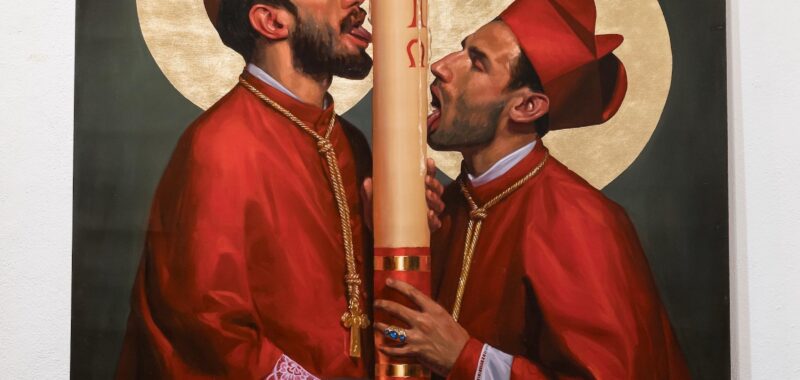A Mexico City exhibition of paintings portraying sexualized and queer Christian priests and nuns has elicited fervent complaints from religious groups and right-wing figures who have held protests at the museum for over a week.
Artist Fabián Cháirez’s exhibition La venida del Señor (The coming of the Lord) opened on February 5 at the Academia de San Carlos Centro Historico, a building affiliated with the National Autonomous University of Mexico (UNAM) in Mexico City. Consistent with the artist’s practice of entwining sexual diversity and subversions of traditional gender roles in retellings of Mexican history and Christianity, the series of nine paintings dating from 2018 to 2023 show consecrated women and men in suggestive poses.
“It’s an exercise in which I make a comparison between religious ecstasy and sexual ecstasy, two things that would appear to be opposites but actually have more in common,” Cháirez told Hyperallergic in Spanish over WhatsApp.
Some paintings feature the nuns with their eyes shut in ecstasy, using glasses of wine or folds in robes as allusions to digital penetration, while priests are depicted performing individual or group fellatio on melting altar candles, kneeling on all fours to drink red wine from a cup, and licking Jesus Christ’s nailed feet on the crucifix.

Incensed by the exhibition’s contents, the Mexican chapter of the Association of Christian Lawyers (AAC) says it filed a legal complaint against Cháirez with the National Council to Prevent Discrimination (CONAPRED), a government agency established in 2003 to promote policies for equality and resolve complaints of alleged discriminatory acts. As reported by Infobae, the AAC’s complaint was digitally signed by 9,000 people and claims that La venida del Señor “violates the right to freely profess one’s faith without being the object of attacks,” citing Article 24 of the Mexican Constitution.
AAC declined to provide comment via email, citing the confidential nature of the complaint.
“There is a double standard from the public that feels offended,” Cháirez explained to Hyperallergic, adding that many of the complainants are “characters who self-define as ‘the new Mexican right-wing.’” Conservative figures such as Mexican Senator Lilly Téllez, Luis Felipe Calderón Zavala (son of former Mexican President Felipe Calderón), and “ultra-conservative” actor and far-right leader Eduardo Verástegui voiced their disdain for the exhibition online.
“I think there are other issues we should be protesting against, such as the church’s abuse of power and sexual abuses within the church,” the artist continued.
Beyond the AAC’s complaints, the exhibition has faced multiple protests onsite from groups taking offense to Cháirez’s portrayals. On Valentine’s Day, February 14, Catholic protesters organized outside the Academia de San Carlos with signs that read “Blasphemy is not art” and accused the artist of bringing about “Christianophobia” in Mexico.
Another intervention occurred inside the gallery yesterday, February 19, when members of UNAM’s Catholic community entered the space and staged a symbolic closure of the show with caution tape, signs, and t-shirts emblazoned with the phrase “No ofendas mi fe en nombre del arte” (“Don’t offend my faith in the name of art”). The action was peaceful and the participants left without incident.
“As an artist and member of the LGBTQ community, the fact that the far right is making gains is quite uncomfortable,” Cháirez continued. “But it’s important that we reconsider our strategies to confront any violence that we might face, especially by seeking community and trying to connect with people in real life who might think differently from us and exist in other contexts — by sharing information so that others can understand difference, freedom of expression, freedom of artistic expression, and all freedoms.”


Right: In a latex luchador mask, Fabián Cháirez poses onsite between two paintings from the solo exhibition.
This isn’t the first time Cháirez’s artwork has drawn criticism, particularly for its LGBTQ+ content or interpretations of the paintings as such. A 2019 exhibition devoted to Mexican revolutionary leader Emiliano Zapata at the Museo del Palacio de Bellas Artes in Mexico City became the site of a protest that escalated into violence between representatives of the nation’s farmworker unions and LGBTQ+ activists over the inclusion of the artist’s 2014 portrait of a nude Zapata with a pink sombrero and seated pin-up style on a horse. The museum kept the painting on view but removed it from the exhibition’s publicity campaign and added a wall text expressing the Zapata family’s disagreement with Cháirez’s representation.
With regards to La venida del Señor, Cháirez said that UNAM has taken some security measures for visitors and staff since the beginning of protests to avoid additional tensions with the public, “but so far there are no indications that the show will be closed, and I think that’s a very positive stance on their part.”
Valentina Di Liscia contributed reporting and translation assistance.

